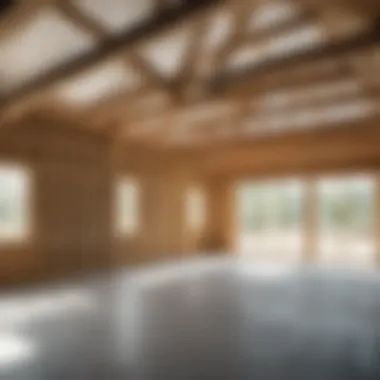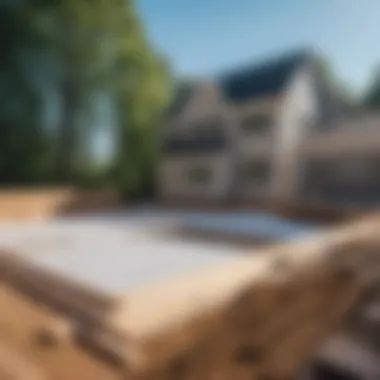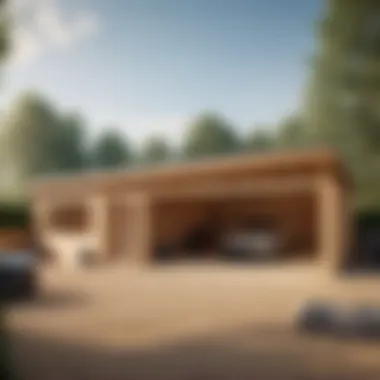Materials:
- Lumber: 2x4 studs, 4x4 posts, and plywood for framing and wall construction
- Concrete: Bags of concrete mix for the foundation and flooring
- Siding: Exterior siding material for the garage walls
- Roofing: Shingles or metal roofing material for the garage roof
- Doors: Garage doors, hinges, and handles
- Windows: For natural light and ventilation
- Fasteners: Nails, screws, and other hardware
- Insulation: To regulate temperature inside the garage
- Tar paper and flashing: For weatherproofing
- Paint or stain: Finishing touches for aesthetics
Ensure to measure and plan the quantities of each material accurately to avoid shortages or wastage.
DIY Steps:
Once you have gathered all the necessary materials, it's time to delve into the step-by-step process of adding a detached garage to your house. Follow these detailed instructions for a seamless construction experience:
- Site Preparation: Clear the area, level the ground, and mark out the garage's footprint.
- Foundation: Dig and pour the concrete foundation according to the garage's dimensions.
- Framing: Build the frame using the lumber, following the architectural plans.
- Walls and Roof: Install siding for walls, then add the roof structure and roofing material.
- Doors and Windows: Incorporate garage doors and windows for functionality and aesthetics.
- Insulation and Finishing: Insulate the garage for energy efficiency and finish with paint or stain.
- Electrical and Lighting: Install electrical outlets and lighting fixtures as needed.
- Landscaping: Complete the project with landscaping around the garage for curb appeal.
Technical Aspects:
- Tools: Basic carpentry tools, concrete mixer, roofing nailer, power drill, etc.
- Timing: Allow ample time for each construction phase, considering drying and curing times.
- Techniques: Use proper framing techniques, ensure precise measurements, and follow safety guidelines.
Implementing these technical aspects will elevate the quality of your DIY project and ensure a structurally sound and visually appealing detached garage.
DIY Project Process:


As you progress through the DIY project of adding a detached garage to your house, adhere to the following sequential steps for a successful construction journey:
- Installation Method: Follow the construction plans meticulously, ensuring accurate measurements and solid structural connections.
- Key Techniques: Utilize moisture barriers for weather protection, insulate thoroughly for energy efficiency, and secure roofing materials correctly.
- Timings: Coordinate each step's timing with precision to avoid delays and ensure a timely completion.
- Troubleshooting Tips: Be ready to address common challenges such as uneven foundation settling, water leakage, or electrical issues promptly.
By following these sequential steps and incorporating key techniques and timings, you can navigate through the DIY project smoothly and troubleshoot any issues that may arise, resulting in a successful addition of a detached garage to your house.
Introduction


When contemplating the addition of a detached garage to a house, numerous considerations come into play, transforming the property and enhancing its functionality. This pivotal decision in home improvement can significantly impact the overall value and utility of the residence. By understanding the intricacies involved in this process, homeowners can embark on a journey towards not only creating more space but also increasing the appeal and practicality of their property.
The introduction sets the stage for delving deep into the realm of detached garage construction, shedding light on the importance of this project in elevating the living experience. From exploring the benefits of enhanced property value and additional storage space to the flexibility in design and the reduction of noise and fumes within the household, each aspect contributes to a comprehensive overview of what adding a detached garage entails.
Since the garage serves as a focal point for vehicle storage, the advent of a detached structure offers a myriad of advantages beyond mere functionality. By dissecting the core elements of this introduction, aspiring homeowners can gain valuable insights into the world of detached garage addition, enabling them to make informed decisions and embark on a transformational journey that blends aesthetics with practicality.
Benefits of Adding a Detached Garage


Increased Property Value
The addition of a detached garage can significantly boost the property value. Appraisers often consider a garage as a valuable asset, especially in areas where parking space is limited. Potential homebuyers are willing to pay more for a house with a detached garage, increasing the resale value of the property. Additionally, a well-designed and secure garage can elevate the curb appeal, attracting potential buyers and enhancing the overall aesthetics of the home.
Additional Storage Space
One of the primary advantages of adding a detached garage is the extra storage space it provides. Homeowners can utilize the garage to store seasonal items, tools, equipment, and other belongings, freeing up space in the main house. This storage solution helps declutter living areas and create a more organized and functional environment within the property.
Flexibility in Garage Design
When adding a detached garage, homeowners have the flexibility to customize the design to suit their specific needs and preferences. From choosing the size and layout to selecting architectural elements and finishes, garage design allows for personalization. Whether it's incorporating workspace areas, installing shelving for organization, or adding aesthetic features, the design possibilities are endless, enabling homeowners to create a garage that meets their unique requirements.
Reduction in Noise and Fumes
A detached garage can help reduce noise and fume infiltration into the main house. By separating the garage from the living spaces, noise from vehicle engines, power tools, and other activities is kept at a distance. This separation also minimizes the entry of fumes, such as exhaust emissions, paints, or chemicals, into the house, promoting a healthier indoor environment for occupants.
Design Considerations
Garage Location
Selecting the optimal location for the detached garage is essential. Factors such as access to the main house, convenience of entry and exit, and landscaping should all be taken into account. The garage location should also comply with local building codes and zoning regulations to avoid any legal issues down the road.
Size and Layout
Determining the size and layout of the garage is a significant decision that impacts its usability and overall impact on the property. Considerations such as the number of vehicles to accommodate, additional storage needs, and potential future uses of the garage should be carefully evaluated during the planning phase. The layout should prioritize functionality while reflecting the overall design aesthetic of the house.
Architectural Style
The architectural style of the detached garage should complement the existing house to create a cohesive and visually appealing property. Whether opting for a traditional, modern, or customized design, it's essential to consider factors such as roof pitch, materials, and overall aesthetics to ensure a harmonious integration with the main dwelling.
Legal and Permit Requirements
When considering the addition of a detached garage to a house, legal and permit requirements play a crucial role in ensuring a smooth and compliant construction process. Understanding and adhering to these regulations not only protects the homeowner from potential legal issues but also enhances the overall safety and quality of the project.
Zoning Regulations
Zoning regulations are governmental rules that dictate how properties can be developed and used within a specific area. When adding a detached garage, homeowners need to comply with these regulations to ensure that the structure meets the size, height, setback, and design requirements set by the local zoning authority. Failure to abide by these regulations can result in fines, delays, or even the removal of the garage.
It is essential to research and understand the zoning regulations applicable to your property before designing or building a detached garage. Consulting with local building authorities or zoning boards can provide valuable insight into the specific requirements that need to be met.
Building Permits
Before starting any work on the garage, homeowners must obtain the required permits. This typically involves submitting detailed construction plans, obtaining approval from the building department, and paying the associated permit fees. Inspections may also be necessary at various stages of the construction process to ensure compliance with building codes.
Homeowner's Association Approval
For homeowners residing in a community governed by a homeowner's association (HOA), obtaining approval from the HOA is another critical aspect of adding a detached garage. HOAs often have specific architectural guidelines and restrictions that outline the acceptable design, size, and aesthetic elements of any external structures, including detached garages.
The approval process usually involves submitting detailed plans and specifications to the HOA architectural committee for review. Homeowners may need to make adjustments to their garage design to align with the HOA's guidelines. Failure to obtain HOA approval can lead to fines, forced modification, or legal action, emphasizing the importance of following the association's regulations.
Construction Process
When embarking on the journey of adding a detached garage to your house, the construction process plays a pivotal role in bringing your vision to life. This section delves into the crucial steps involved in actualizing your garage addition project, emphasizing precision and quality execution from start to finish.
The construction process encompasses various intricate phases, each contributing significantly to the overall outcome of your detached garage. From site preparation to final touches, attention to detail and adherence to best practices are paramount to ensure a structurally sound and aesthetically pleasing result.
Site Preparation
Prior to commencing any construction work, thorough site preparation is imperative. This step involves clearing the designated area, ensuring proper grading, and assessing the land to accommodate the new structure seamlessly. Site preparation sets the foundation for a smooth construction process, laying the groundwork for subsequent stages.
Foundation and Framing
The foundation serves as the backbone of your detached garage, providing stability and structural integrity. From excavation to concrete pouring, meticulous attention to detail is essential to construct a solid and durable foundation. Once the foundation is in place, framing comes into play, shaping the skeleton of your garage with precision and accuracy.
Roofing and Siding
Roofing and siding are not just aesthetic elements but also key components in protecting your garage from the elements. Selecting high-quality roofing materials and durable siding options is crucial for longevity and weather resistance. Proper installation techniques ensure a watertight and secure enclosure for your vehicles and belongings.
Electrical and Plumbing Installation
The electrical and plumbing aspects of your detached garage require expert handling to ensure functionality and safety. Electrical wiring for lighting, outlets, and garage door operation should adhere to code requirements. Additionally, plumbing installation for utility sinks or irrigation systems calls for professional expertise to guarantee seamless operation.
Cost Estimation
Material Costs
Material costs constitute a significant portion of the overall expenses associated with constructing a detached garage. Factors such as the type of materials, quality, and quantity needed all influence the total cost. Common materials required for building a detached garage include lumber, concrete, roofing shingles, siding materials, doors, windows, and insulation. The selection of high-quality materials is crucial for ensuring the durability and longevity of the garage structure. Additionally, opting for energy-efficient materials may lead to long-term savings on utility bills.
Labor Costs
Labor costs encompass the expenses related to hiring professionals for the construction of the detached garage. The labor costs vary depending on factors such as the size and complexity of the project, prevailing wage rates in the local area, and the experience level of the construction crew. It is imperative to obtain detailed quotes from reputable contractors to accurately estimate the labor expenses. Skilled labor is essential for ensuring the quality and safety of the garage construction.





